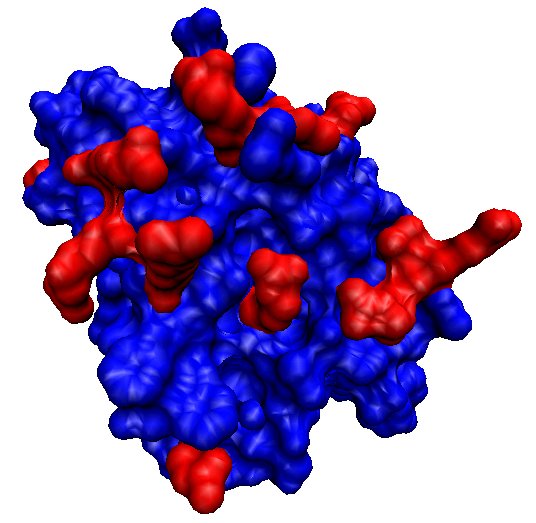12.8: Fighting Cancer with Inhibitors of Angiogenesis
- Page ID
- 5090
Once a nest of cancer cells reaches a certain size (1–2 mm in diameter), it must develop a blood supply in order to grow larger. Diffusion is no longer adequate to supply the cells with oxygen and nutrients and to take away wastes. Cancer cells (probably like all tissues) secrete substances that promote the formation of new blood vessels — a process called angiogenesis. Over a dozen substances have been identified that promote angiogenesis. A few examples are angiopoietin-1, the basic fibroblast growth factor (bFGF) and the vascular endothelial growth factor (VEGF).
Curiously, some tumors also secrete substances that inhibit angiogenesis. This explains a clinical phenomenon that has been known for decades:
- A patient has a tumor, the so-called primary tumor.
- There is no evidence that the primary tumor has metastasized.
- A surgeon removes the primary tumor.
- Some weeks later metastases of the tumor appear throughout the patient's body
- The speed of their appearance indicates that they were present all along, but too small to be detected.
This phenomenon caused Dr. Judah Folkman of Children's Hospital and the Harvard Medical School in Boston to hypothesize that a large primary tumor secretes not only stimulators of its own angiogenesis but angiogenesis inhibitors that are released into the circulation and inhibit angiogenesis — and thus further growth — of any metastases of the primary tumor. A number of inhibitors of angiogenesis have been discovered.
Angiostatin
Angiostatin is a polypeptide of approximately 200 amino acids. It is produced by the cleavage of plasminogen, a plasma protein that is important for dissolving blood clots. Angiostatin binds to subunits of ATP synthase exposed at the surface of the cell embedded in the plasma membrane. (Before this recent discovery, ATP synthase was known only as a mitochondrial protein.)
Endostatin
Endostatin is a polypeptide of 184 amino acids. It is the globular domain found at the C-terminal of Type XVIII (18) collagen (a collagen found in blood vessels) cut off from the parent molecule.

Effects of angiostatin and endostatin in mice
Injections of angiostatin inhibit the metastasis of certain (mouse) primary tumors. Injections of endostatin (made by recombinant DNA technology) cause the primary tumor to regress. In time, the primary tumor reappears, but a repeat injection causes it to regress again. Each time it reappears, the tumor is just as susceptible to treatment as before. After a few cycles of growth, treatment, and regression, the primary tumor finally stops growing (at least in the cases examined) and remains dormant at a small size.
Some human tumors can be grown in immunodeficient mice. (Being immunodeficient, they cannot reject this foreign tissue). Treatment with endostatin caused these human tumor masses to shrink in their mouse host. Combined treatment with both angiostatin and endostatin has caused some primary mouse tumors to disappear entirely.
This is not seen with conventional chemotherapy. Repeated exposure to chemotherapeutic drugs selects for the appearance of drug-resistant tumor cells. Eventually, further drug treatment is worthless. Why the difference in response? Chemotherapy works directly on tumor cells which mutate easily. Angiogenesis inhibitors don't work on the tumor cells but on normal cells involved in the formation of blood vessels.
Other Angiogenesis Inhibitors
Epithelial cells express transmembrane proteins on their surface — called integrins — by which they anchor themselves to the extracellular matrix. It turns out that the new blood vessels in tumors express a vascular integrin — designated alpha-v/beta-3 — that is not found on the old blood vessels of normal tissues.
Vitaxin®, a humanized monoclonal antibody directed against the alpha-v/beta-3 vascular integrin, shrinks tumors in mice without harming them. In Phase II clinical trials in humans, Vitaxin has shown some promise in shrinking solid tumors without harmful side effects.
What does the future hold for angiogenesis inhibitors?
Clinical trials of endostatin (manufactured by recombinant DNA technology), in combination with standard chemotherapy have shown some benefit in one type of lung cancer.
Bevacizumab (Avastin®). This is a humanized monoclonal antibody that binds to VEGF thus keeping it from binding to its receptors. Approved by the US FDA in February 2004 for the treatment of colorectal cancers.
Ranibizumab (Lucentis®) is a modified version of Avastin® that is showing great promise in inhibiting the formation of new blood vessels in the retina — the cause "wet" macular degeneration.
Trials are also scheduled to begin on a synthetic ribozyme that blocks synthesis of the VEGF receptor. These are only a few examples of the ~50 antiangiogenesis drugs now in clinical trials.
But proceed with caution.
In animal studies, some cancers — notably pancreatic cancer — have turned out to resist chemotherapy because of their poor blood supply. Perhaps such cancers need to have angiogenesis promoted; inhibiting it could make a bad problem worse.


